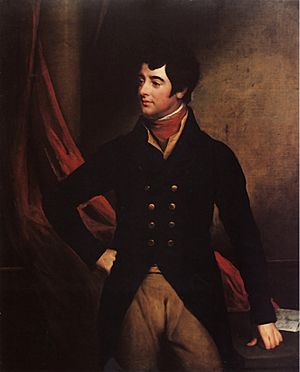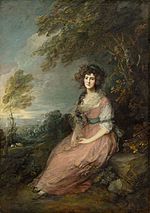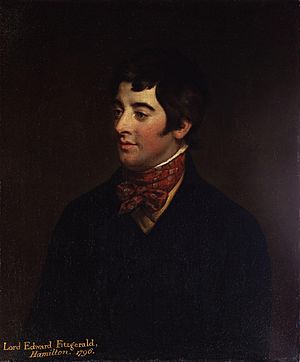Lord Edward FitzGerald facts for kids
Quick facts for kids
Lord Edward FitzGerald
|
|
|---|---|
 |
|
| Born | October 15, 1763 Carton House, County Kildare, Kingdom of Ireland |
| Died | 4 June 1798 (aged 34) Newgate Prison, Dublin, Kingdom of Ireland |
| Buried | |
| Allegiance | |
| Service/ |
|
| Years of service | 1779–1790 |
| Rank | Major |
| Battles/wars | Battle of Eutaw Springs |
| Spouse(s) | Stéphanie Caroline Anne Syms |
| Children |
|
| Relations |
|
Lord Edward FitzGerald (born October 15, 1763 – died June 4, 1798) was an important Irish leader. He was born into a noble family. He served in the British Army and was a member of the Irish Parliament.
However, he believed Ireland should be a free country. He wanted Ireland to be a republic, like France. He joined the Society of United Irishmen. This group wanted to make Ireland independent. Lord Edward FitzGerald helped plan a rebellion against British rule. He was badly hurt during his arrest and died in prison. He is remembered as a hero in Irish history.
Contents
- Early Life and Family
- Serving in the American War
- After the War: Military and Politics
- Exploring the New World
- Entering Politics in Ireland
- Marriage in France
- Return to Ireland and Revolution
- Planning the Uprising
- The Net Closes In
- Arrest and Tragic Death
- His Legacy
- Family Life
- Memorials and Honors
- Images for kids
Early Life and Family
Edward FitzGerald was the fifth son of the first Duke of Leinster. His mother was Lady Emily Lennox. He was born at Carton House near Dublin. His family was part of the Fitzgerald dynasty.
When he was ten, his father passed away. His mother then married William Ogilvie. Ogilvie had been Edward's teacher. Edward spent most of his childhood at Frescati House in Blackrock. Ogilvie taught him things that would help him in a military career.
Serving in the American War
In 1779, Edward FitzGerald joined the British Army. He became an aide to Lord Rawdon. He fought in the American Revolutionary War.
He was seriously injured at the Battle of Eutaw Springs in 1781. An escaped slave named Tony Small saved his life. Tony Small was known as "Faithful Tony." Lord Edward later had a portrait painted of Tony Small. He also freed Tony and employed him for the rest of his life.
In 1782, British forces left Charleston. FitzGerald was taken out of the city. He saw how American colonists fought against regular soldiers. This might have made him believe that Irish people could do the same.
After the War: Military and Politics
After the war, FitzGerald visited the West Indies. He then returned to Ireland in 1783. His brother, the second Duke of Leinster, helped him get elected. Edward became a member of the Irish Parliament for Athy. He held this seat until 1790.
In Parliament, he joined a small group called the Irish Patriot Party. This group was led by Henry Grattan. Edward did not speak much in debates.
In 1786, he went to the Military College, Woolwich. Then he traveled through Spain in 1787. He was sad because his cousin Georgina Lennox did not return his feelings. She later married the third Earl Bathurst. Because of this, he sailed to New Brunswick to join the 54th Regiment as a Major.
Exploring the New World
In April 1789, FitzGerald went on an adventure. He traveled from Fredericton, New Brunswick to Quebec with another officer. They used a compass to guide them. Along the way, they met and befriended Native Americans.
He completed the journey, which was about 225 miles, in 26 days. This trip helped create a shorter route than what was used before. This route crossed a very wild and forested area.
On another trip, he was formally adopted by the Bear clan of the Kanien'kehá:ka (Mohawk) in Detroit. He was given the name "Eghnidal" by Karonghyontye (Captain David Hill). He then traveled down the Mississippi River to New Orleans. From there, he returned to England.
Entering Politics in Ireland

His brother had arranged for him to be elected for County Kildare. He held this seat from 1790 to 1798. Lord Edward wanted to be politically independent. He turned down a command to lead an expedition against Cadiz. This offer came from Pitt.
Instead, he focused on social life and his duties in Parliament. He was close friends with Charles James Fox and Richard Brinsley Sheridan.
Marriage in France
FitzGerald visited Paris in October 1792. He was very interested in the ideas of the French Revolution. He stayed with Thomas Paine and listened to political discussions. At a gathering, he supported getting rid of all noble titles. He even gave up his own title. Because of this, he was dismissed from the army.
While in Paris, FitzGerald met a young woman named Pamela (1773–1831). She was a protégée of Stéphanie Félicité, comtesse de Genlis. On December 27, 1792, FitzGerald and Pamela got married in Tournai. One of the witnesses was Louis Philippe, who later became King of the French. In January 1793, they arrived in Dublin.
Return to Ireland and Revolution

When Lord Edward returned to Ireland, there was a lot of unrest. The Society of the United Irishmen was growing popular. This group wanted big changes. They had to go underground when France and Britain went to war in 1793.
Lord Edward FitzGerald had just been in Paris. He immediately spoke out in support of the United Irishmen in the Irish Parliament. He was even ordered to apologize for criticizing a government order. This order was meant to stop the United Irishmen.
However, he did not officially join the United Irishmen until 1796. By then, the group had given up on peaceful changes. Their goal was to create an independent Irish republic.
Planning the Uprising
In May 1796, Theobald Wolfe Tone was in Paris. He was trying to get help from France for an uprising in Ireland. At the same time, FitzGerald and his friend Arthur O'Connor went to Hamburg. They talked with French officials there.
The government in London learned about these plans from an informer named Samuel Turner. Pamela, Lord Edward's wife, knew all his secrets. She helped him with his plans. The talks in Hamburg led to a French expedition to Bantry Bay in December 1796, but it failed.
By September 1797, the government knew Lord Edward was a leader in the United Irishmen conspiracy. He was in charge of the military organization. He had papers showing that many men were ready to fight. They had some weapons, but not enough. The leaders hoped for a French invasion to help them.
But French help was slow to arrive. The rebel leaders in Ireland disagreed about whether to start the uprising without foreign help. Lord Edward was one of those who wanted to act boldly.
The Net Closes In
The government wanted to avoid arresting FitzGerald. He was from a powerful family. They offered to let him leave the country. The Lord Chancellor, Lord Clare, told his family to get him out. He said the ports would be open for him to escape.
However, FitzGerald refused to leave. He did not want to abandon others he had led into danger. On March 30, the government declared martial law. This meant the military could act freely to crush the United Irishmen. This led to harsh actions in many parts of the country. Because of this, the United Irish leaders decided to start the uprising sooner.
Arrest and Tragic Death

Lord Edward FitzGerald was the most important United Irish leader still free. On May 9, a reward of £1,000 was offered for his capture. After other leaders were arrested, FitzGerald went into hiding. But he still visited his wife and was visited by his stepfather. He was not as careful as he should have been.
The uprising was set for May 23. FitzGerald was hiding in the house of Nicholas Murphy in Thomas Street, Dublin. On May 18, Major Henry Sirr and soldiers stormed Murphy's house. Lord Edward was in bed with a fever.
When he heard the commotion, FitzGerald jumped up. He refused to surrender peacefully. He fought back with a dagger, stabbing Captain William Bellingham Swan and badly wounding Captain Daniel Frederick Ryan. Major Sirr shot him in the shoulder to stop him.
FitzGerald was taken to New Prison, Dublin. He did not get proper medical care. His wound became infected. His wife had fled the country. Lord Edward's brother Henry and his aunt Lady Louisa Conolly were allowed to see him. Lord Edward died on June 4, 1798, at age 34. The rebellion was happening outside.
He was buried the next day at St Werburgh's Church, Dublin. His property was taken by the government, but this was later reversed in 1819. The dagger he used was later stolen from Major Swan's house. His dagger's scabbard is kept at Limerick Museum.
His Legacy
Lord Edward FitzGerald's sister, Lady Lucy FitzGerald, spoke about his loyalty to Ireland. She said he gave up everything for his country. He loved his countrymen more than himself. He wanted no other title than "Paddy," a common name for an Irishman.
People in Ireland remember FitzGerald as brave and kind. He was a clever planner. His death was a great loss. His funeral was held in secret at 2 AM to avoid large crowds. Soldiers stopped and searched the funeral procession. Even after he was buried, the mourners had to stay in the church until they got passes to leave.
Family Life
Lord Edward FitzGerald and Pamela had three children:
- Edward Fox FitzGerald (born 1794 – died 1863). He married Jane Paul.
- Pamela FitzGerald (born 1795/1796 – died 1869). She married Sir Guy Campbell, 1st Baronet.
- Lucy Louisa FitzGerald (born 1798 – died 1826). She married Capt. George Francis Lyon.
Memorials and Honors
Many streets in Ireland are named Lord Edward Street. You can find them in cities like Dublin, Limerick, Sligo, and Kilkenny.
Sporting Associations
Two GAA clubs are named after him. The County Roscommon club Tulsk Lord Edward's is named for him. The Geraldines P. Moran GAA club in Cornelscourt, Dublin, is also partly named after him.
Images for kids
-
"Mrs Richard Brinsley Sheridan" by Thomas Gainsborough.
-
Portrait of Edward FitzGerald by Hugh Douglas Hamilton, 1796.
-
Arrest of Lord Edward FitzGerald by George Cruikshank.




